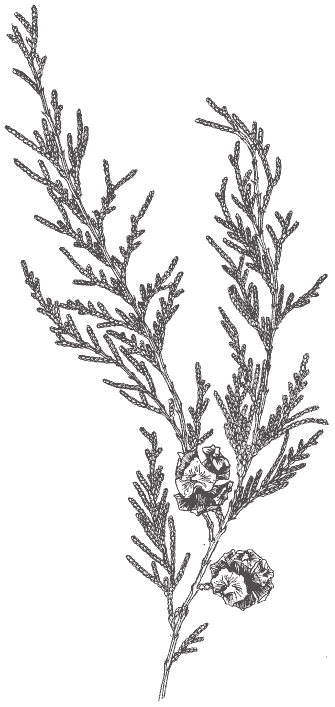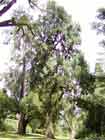Cupressus
Linnaeus 1753, p. 1002
Common names
Cypress (Eckenwalder 1993).
Taxonomic notes
There are 14 species in Cupressus:
Cupressus was a hot topic in conifer systematics during the first decade of the 21st Century, with various proposals to subdivide it into multiple genera. I will not belabor the history of this controversy, but will summarize it as follows:
- 2002: Farjon et al. describe a new cypress species from Viet Nam, assigning it to a new genus, Xanthocyparis. They also take one of the most unconventional species of Cupressus, C. nootkatensis (assigned by some to Chamaecyparis), and assign it to the new genus.
- 2006: Little, performing detailed molecular analysis of all species in the genus, concludes that Cupressus is paraphyletic: the New World cypresses diverged from a clade that later produced Juniperus. He assigns the New World cypresses and X. nootkatensis to the genus Callitropsis (an old name for X. nootkatensis).
- 2009: Adams et al. (2009) assign X. nootkatensis to the monotypic genus Callitropsis and assign the remaining New World cypresses to a new genus, Hesperocyparis. Independently, and only days later, de Laubenfels does the same thing, but he erects the genus Neocupressus.
- 2010: Mao et al. perform a still more detailed molecular analysis that includes nearly all species in Juniperus, Cupressus, Chamaecyparis, Xanthocyparis, and several related monotypic genera. The analysis indicates that Cupressus (sensu strictu) plus Xanthocyparis plus Hesperocyparis comprise a monophyletic clade, sister to Juniperus.
- 2018: Zhu et al. (2018) perform a plastid genome analysis addressing 16 taxa including Cupressus, Juniperus, Callitropsis, Hesperocyparis, Xanthocyparis, and outgroup taxa in the Cupressaceae. Results consistently group Callitropsis, Hesperocyparis, and Xanthocyparis together, but disagree in whether this group is sister to Cupressus or to a Cupressus+Juniperus clade. The authors suggest this incongruence could be explained by an ancient hybridization event, likely affecting hybridization between Cupressus and Juniperus ca. 40-60 million years ago, subsequent to the differentiation of the largely New World clade of Hesperocyparis and its allies. Also, Terry et al. (2018) perform an analysis of the group that considers multiple lines of molecular evidence and uses multiple analytical methods; this analysis also finds Cupressus sister to Juniperus, and provides detail on cladistic structure within Cupressus.
- 2019: Mao et al. (2019), considering nuclear transcriptome data for 20 taxa, also find strong support for a Callitropsis-Hesperocyparis-Xanthocyparis clade, as well as for a Cupressus-Juniperus clade, but, "strongly supported conflicts among individual gene trees were also detected." Their molecular clock analysis suggests the groups diverged about 60 million years ago, with Cupressus-Juniperus divergence about 56 million years ago; the clade appears to have originated in Asia, with subsequent dispersal to North America, Europe, and Africa. They conclude that "rapid evolutionary divergence and incomplete lineage sorting probably acted together as the source for conflicting phylogenetic inferences between gene trees."
Thus, a long sequence of studies, considering a variety of lines of molecular evidence (and using molecular methods that improved considerably during a period of almost 20 years), uncovered unsuspected complexities in the appearance of precursors to the modern taxa, over 50 million years ago. The result, in phylogenetic terms, was that all of the New World cypresses, some of which had been known to botanists since the 1600s, were reassigned to new genera: the monotypic Callitropsis and Xanthocyparis, and 17 species of Hesperocyparis, leaving Cupressus sensu strictu as comprising the Old World cypresses. (I should note that it remains a mystery how Xanthocyparis ended up in Viet Nam, for all cited analyses have consistently placed it with the New World taxa.)
Within Cupressus, most recognized species were addressed in the analysis of Terry et al. (2018), which considered both nuclear and chloroplast sequences. The nuclear analysis identified 3 geographically-distinct clades: a basal clade containing the Himalayan/Tibetan species C. cashmeriana, C. torulosa, C. gigantea, and C. duclouxiana; a sister clade of Africa, Europe and west Asia containing C. dupreziana, C. atlantica and C. sempervirens; and these two sister to a third southeast Asian clade containing C. chengiana and C. funebris. The chloroplast analysis also identified these 3 clades, but two varieties of C. chengiana were placed within the basal clade, albeit with low confidence. However, Maerki (2020) points out that the authors misidentified at least two specimens, which introduces significant uncertainty to the conclusions.
Description
Trees or large shrubs, evergreen. Branchlets terete or quadrangular, in decussate arrays in most species; flattened (comblike), superficially resembling Chamaecyparis or Thuja in others. Leaves opposite decussate in 4 ranks, rarely in alternating whorls of 3 in 6 ranks. Adult leaves appressed to divergent, scalelike, rhomboid, free portion of long-shoot leaves to 4 mm; abaxial gland present or absent. Pollen cones with 4-10 pairs of sporophylls, each sporophyll with 3-10 pollen sacs. Seed cones maturing in (?1-)2 years, exact maturation period poorly researched, mostly varying from about 16-25 months after pollination; generally persisting closed many years or until opened by fire, but opening on maturity, and falling soon after seed release, in a few species; globose or oblong, 8-43 mm; scales persistent, (2)3-6(7) opposite decussate pairs, valvate, peltate, thick and woody, the terminal pair either fused or open with a small central columella (varying from cone to cone on a single tree). Seeds (3)5-20 per scale, lenticular or faceted, narrowly 2-winged; cotyledons 2-5. x= 11 (Eckenwalder 1993, Frankis 1999).
Distribution and Ecology
Cool north temperate regions to the northern subtropics: NW Africa, Middle East and eastward along the Himalaya to SW & Central China and Viet Nam. This table summarizes the species by their general areas of native distribution, listing them roughly from west to east:
| Species |
Distribution |
| C. atlantica |
Southern Morocco. |
| C. sempervirens |
Circum-Mediterranean. |
| C. dupreziana |
Extremely local in Algeria. |
| C. torulosa |
Himalaya: Pakistan to Yunnan (China). |
| C. cashmeriana |
Arunachal Pradesh (India). |
| C. majestica |
China: Xizang (SE Tibet). |
| C. austrotibetica |
China: Xizang (further E in SE Tibet). |
| C. rushforthii |
China: Xizang (further E in SE Tibet). |
| C. fallax |
China: Sichuan. |
| C. chengiana |
China: Sichuan. |
| C. gansuensis |
China: Sichuan and Gansu. |
| C. duclouxiana |
China: Guizhou, SW Sichuan, C and NW Yunnan, and SE Xizang (Tibet). |
| C. funebris |
Viet Nam and most of S China (Anhui, Fujian, Gansu, N Guangdong, N Guangxi, E Guizhou, Henan, W Hubei, Hunan, Jiangxi, Shaanxi, Sichuan, Yunnan, and Zhejiang). |
| C. tonkinensis |
Extremely local in Viet Nam. |
Remarkable Specimens
Cupressus contains more species that attain really large sizes than any other genus in the family. Data are not yet available for a number of species, but of the documented ones, C. gigantea seems to be the leader; the data are vague and unreliable but of several published estimates, the smallest place it at 480 cm dbh and 46 m tall. More significantly, in 2023 Chinese scientists reported finding a C. rushforthiana cypress in the Yarlung Tsangpo gorge 102.3 m tall! This is the tallest tree in the world outside of California (where Sequoia grows substantially taller).
There are few good data for C. cashmeriana; is said to attain 95 m in height, and a 61 m tall specimen is known. I have seen photos that appear to give it diameters at or close to 300 cm. C. dupreziana subsp. dupreziana is said to get to 380 cm dbh and 22 m tall, which is quite impressive for such a rare taxon (the last census found 233 living specimens). The remaining species are less than 300 cm dbh, in other words, some of them are still quite impressive, especially considering their affinity for relatively hostile habitats such as deserts and high mountains.
There are few data on ages of Cupressus in general. There is a radiocarbon age of 2200 years for a specimen of C. dupreziana.
Ethnobotany
Several species are of horticultural importance; fastigiate forms of C. sempervirens, C. duclouxiana and C. funebris have been cultivated for ornament for several thousand years in the Mediterranean region and S China respectively, and the highly decorative weeping C. cashmeriana has been tended for many centuries around Buddhist temples in Sikkim, Bhutan, Assam and nearby areas of Tibet and India.
The wood is valued for its sweet scent and resistance to decay. Famous uses of the wood (of C. sempervirens) include Noah's Ark (The Bible, Genesis 6:14), and the doors to St. Peter's, Vatican City, Rome, which were still sound after 1,100 years' use (Loudon, 1838; reference misplaced).
Several species have proven useful in dendrochronological research, including studies of climate reconstruction, archeological dating, and ecological studies. The genus appears to be less intractable than much of the Cupressaceae with regard to such problems as poor ring boundaries, false rings, and poor circuit uniformity. See the individual species for details.
Observations
See the species accounts. Many temperate zone arboreta contain good collections, too.
Remarks
The genus name is from the Roman name for C. sempervirens, itself a loan word via Greek Kuparissos from Hebrew Gopher (Frankis 1992).
Citations
Adams, Robert P., Jim A. Bartel and R.A. Price. 2009. A new genus, Hesperocyparis, for the cypresses of the western hemisphere. Phytologia 91(1):160-185.
Frankis, Michael P. 1992. Cupressus. In: Griffiths et al. (eds) The New RHS Dictionary of Gardening 1: 781-783.
Frankis, Michael P. 1999. Contributions based on personal experience, via e-mail, 1999.02.03.
Maerki, Didier. 2020. On the taxonomy of the Asian Cupressus species. Bulletin of the Cupressus Conservation Project 9(2):68–72.
Mao, Kangshan, Markus Ruhsam, Yazhen Ma, Sean W. Graham, Jianquan Liu, Philip Thomas, Richard I. Milne, and Peter M. Hollingsworth. 2019. A transcriptome-based resolution for a key taxonomic controversy in Cupressaceae. Annals of Botany 123(1):153–167. https://doi.org/10.1093/aob/mcy152.
Terry, Randall G., Jim A. Bartel, and Robert P. Adams. 2012. Phylogenetic relationships among the New World cypresses (Hesperocyparis; Cupressaceae): evidence from noncoding chloroplast DNA sequences. Plant Systematics and Evolution DOI: 10.1007/s00606-012-0696-3.
Terry, Randall G., Andrea E. Schwarzbach, and Jim A. Bartel. 2018. A molecular phylogeny of the Old World cypresses (Cupressus: Cupressaceae): Evidence from nuclear and chloroplast DNA sequences. Plant Systematics and Evolution 304(10):1181-1197.
Zhu, Andan, Weishu Fan, Robert P. Adams, and Jeffrey P. Mower. 2018. Phylogenomic evidence for ancient recombination between plastid genomes of the Cupressus-Juniperus-Xanthocyparis complex (Cupressaceae). BMC Evolutionary Biology 18(1). https://doi.org/10.1186/s12862-018-1258-2.
See also
The Cupressus Conservation Project provides a wealth of information on old and New World Cupressus, including a taxonomic review, historical accounts, cone photographs, and various other pertinent information.
Farjon, A. 2009. Do we have to chop up the cypresses? Conifer Quarterly 26(4):12-17.
Masters, M.T. 1896. A general view of the genus Cupressus. Journal of the Linnaean Society, Botany 31: 312-363. http://www.cupressus.net/Masters.html, courtesy of the Cupressus Conservation Project website.
Silba, J. 1998. A monograph of the genus Cupressus L. Journal of the International Conifer Preservation Society 5(2):1-98.




